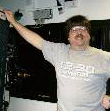|
|
This topic comprises 2 pages: 1 2
|
|
Author
|
Topic: DVD playback on Blu Ray player
|
|
|
|
|
|
|
Julio Roberto
Jedi Master Film Handler
Posts: 938
From: Madrid, Madrid, Spain
Registered: Oct 2008
|
 posted 03-22-2009 06:32 PM
posted 03-22-2009 06:32 PM



Claude:
Now you understand why people are not all-over Blu-ray just yet and were waiting a bit for the prices to go down.
Regular old DVD's always could be made to look really good if they were mastered right and with the right equipment.
In other parts of the world where the PAL television standard is used, the DVD's look even better (due to technical reasons, it has about 20% more pixels per frame and it doesn't need a "pulldown" which screws motion somewhat and shows slightly more real frames per second).
In Europe DVD players have always had RGB outputs through the Euroconector standard (also known as SCART) and thus, even when using an analog DVD player (i.e. not a new HDMI upconverting one), the picture can look really-really good.
Even more so when a digital (HDMI) upconverter DVD player is used (costs as little as $75 nowadays).
So people are happy (enough) with DVD to postpone Blu-ray for a bit.
For people who never upgraded their all-analog, non-component equipment, specially in areas with the NTSC television standard (i.e. USA), then the difference in quality is a bit greater and thus they are more inclined, like you did, to switch all their equipment to all-digital High Definition with blu-ray, which is the right choice anyway, specially since the over-the-air switch to digital with the analog TV being turned-off makes it all a good excuse to buy a new high definition TV. The prices are just about right at this time.
And when done really-really right and with the right equipment, a well mastered blu-ray can, no matter what others may say, look almost as good as a good digital (or projected from 2K pre-digitazed 35mm film) cinema presentation.
No longer there is a big quality difference between average cinema and home watching enviroments at this point in time.
Of course, many studios are not using the quality of blu-ray to its full potential, just like they are often not using the quality of DCI 2K to its fullest either in theaters. And not everybody has a state of the art 65" TV in their homes .... yet ![[Wink]](wink.gif)
I'm so glad you are really enjoying your new A/V setup.
Best regards.
| IP: Logged
|
|
|
|
|
|
|
|
|
|
Julio Roberto
Jedi Master Film Handler
Posts: 938
From: Madrid, Madrid, Spain
Registered: Oct 2008
|
 posted 03-23-2009 11:03 AM
posted 03-23-2009 11:03 AM



Well ... film is run at "48 hz" (with a twin-blade or equivalent shutter) ![[Wink]](wink.gif)
And, BTW, with standard definition TV your choices are:
Analog or digital NTSC
29.97p or 59.94i
Analog or digital PAL
25p or 50i
Which one do you rather have? They all have the "wrong" frame rates for 24p material. The small speed-up (4%, not noticeable) by the PAL system better rids of temporal artifacts while actually increasing the apparent temporal resolution (only 4%, but better than nothing).
With new HD TV sets and sources there is no PAL or NTSC anymore. All countries can use 23.976p, 24p, 25p, 29.97p, 50i or 59.94i, whatever the source needs. We never had a drop frame problem in PAL-land, BTW, as the frame rate is "exact" (but sped up from 24p, i.e.)
And as it has been said, plenty of movies, documentaries and TV programming which original frame rate is 25fps and are actually projected at the wrong speed when shown in film (4% decrease, not noticeable).
Actually, I would root (and in Europe the EC is probably going to demand) for DCI to incorporate a 25fps in their standard. Eventually, when film basically dissapears, movies can start originating in a ever so slightly improved frame rate while maintaining good compatibility and look with legacy 24fps equipment.
Producers in Europe (Australia and many other parts of the world) know that 24p is only a necessity for a month or two of theatrical release and that their products are later going to live most of their lives in TV and videos, where the bigger market that doesn't produce too many problems runs at 25fps. So they are originating their movies at 25fps, then slowing down to 24fps if going theatrical.
http://en.wikipedia.org/wiki/PAL
[link is to a wikipedia article on PAL TV system. It includes a map of the world showing parts using NTSC, PAL and the frame-rate compatible SECAM]
Thank god all this will soon be part of the past as new HD TV's and standards are universal and support natively all frame rates, old and new, anywhere in the world.
But in the US TV production seems to remain 60i or 30p, with motion picture at 24p. In Europe, they are 50i or 25p for TV, 25p for motion picture as well. Converting between 24p and 25p and viceversa has never been much of a problem ![[Wink]](wink.gif)
I wonder how many non-sync mechanical projectors run at exactly 24fps as oppossed to say 24.3 average (or 23.8) ![[uhoh]](graemlins/uhoh.gif)
| IP: Logged
|
|
|
|
Julio Roberto
Jedi Master Film Handler
Posts: 938
From: Madrid, Madrid, Spain
Registered: Oct 2008
|
 posted 03-23-2009 01:08 PM
posted 03-23-2009 01:08 PM



quote: Scott Norwood
I suspect that most are pretty close.
Yeah, I also think that lot are really accurate. Still, many running synchronous motors for auditorium pairing to make sure there is little/no slack.
But it's really nice to finish a 3 hours Harry Potter movie 7 minutes early in PAL TVs!!! And it's not like you can say we didn't see all the frames that were in the movie!
And in NTSC TV's, the movie would last 18 seconds longer still than in the theater!!! ![[Eek!]](eek.gif) ![[Big Grin]](biggrin.gif)
As you know, stuff (movies) shown in TV all over the world including the USA are digitally sped up or slowed down by stations independently of their origin/standard convertion all the time to fit the schedules ... It's done by a small enough amount that average Joe's can not notice.
Otherwise, HBO would have to have movies scheduled at 23:07:12 or find tons of filling material to cover all the breaks from all the movies and the TV guide would have to get their money's worth ![[Wink]](wink.gif)
Part of an article:
quote:
Next time Sam plays ``As Time Goes By'' during a television rerun of ``Casablanca,'' check his tempo. Thanks to the pervasive use of time-compression machines by broadcasters and programmers, Humphrey Bogart's time usually goes by in a New York minute rather than at the languid pace of a Moroccan night.
Since their introduction in the early 1980s as television editing tools, time-compression machines have come to be used frequently by broadcasters to make room for more commercials by accelerating the speed of movies and old television programs. The additional minutes of advertising time come without increased costs for additional programming.
The machines are also used to create an artificial level of enthusiasm among game show contestants and actors in commercials by speeding up the motion while keeping voices at a normal pitch, editors and producers say. ``If you can cut 8 percent of a two-hour movie by speeding it up, you gain almost 10 minutes without cutting any scenes,'' said Tom Roche, videotape editor at Crawford Post-Production in Atlanta, a studio that provides editing services to advertising agencies, television syndicators and other clients.
The devices enable editors to shrink a 31-second soundtrack to fit a 30-second commercial or to create enough room at the end of a commercial to add a new tagline without remaking the entire spot.
In my experience, up to 5% doesn't even start to be noticeable to most people. In 25p-land, which includes a couple of earth's top 3 film producers, India and China ![[Wink]](wink.gif) , there has always been for the past 60 years an increase of 4% in 24p originated film. Nobody that is not into A/V even knows about it, much less is bothered by it. Our programs and some films are seen in the USA 4% slower, and nobody complains either. , there has always been for the past 60 years an increase of 4% in 24p originated film. Nobody that is not into A/V even knows about it, much less is bothered by it. Our programs and some films are seen in the USA 4% slower, and nobody complains either.
Even more convoluted, next time you watch Mr Bean, Monthy Phyton or some BBC documentary, think it was probably slowed down from 50i to 47.952i and then pulled-down to 59.94i so you can watch it in the USA/Canada/Japan ![[beer]](graemlins/beer.gif)
| IP: Logged
|
|
|
|
|
|
Claude S. Ayakawa
Film God

Posts: 2738
From: Waipahu, Hawaii, USA
Registered: Aug 2002
|
 posted 03-23-2009 04:13 PM
posted 03-23-2009 04:13 PM





Bobby,
As a life long professional image maker and a PPA Master Photographer and a photographic lecturer for over 24 years, I am very aware of what makes a good image as far as density, contrast, color harmony among other things including the 'popping' of the imagery. Just to give you an idea what I mean, I can already see the difference in the picture quality between 1080i broadcast HDTV images and 1080p Blu Ray images on my 26 inch Samsung HDTV. When I marveled at the fantastic DVD picture quality of THE TEN COMMANDMENTS the other night on my HDTV, it had beautiful color and picture contrast but compared to what Blu Ray can offer, it was not as sharp as it should be. It will be only a matter of time before this movie is released on Blu Ray and when it does, it will be superb.
-Claude
| IP: Logged
|
|
|
|
|
|
All times are Central (GMT -6:00)
|
This topic comprises 2 pages: 1 2
|
Powered by Infopop Corporation
UBB.classicTM
6.3.1.2
The Film-Tech Forums are designed for various members related to the cinema industry to express their opinions, viewpoints and testimonials on various products, services and events based upon speculation, personal knowledge and factual information through use, therefore all views represented here allow no liability upon the publishers of this web site and the owners of said views assume no liability for any ill will resulting from these postings. The posts made here are for educational as well as entertainment purposes and as such anyone viewing this portion of the website must accept these views as statements of the author of that opinion
and agrees to release the authors from any and all liability.
|

 Home
Home
 Products
Products
 Store
Store
 Forum
Forum
 Warehouse
Warehouse
 Contact Us
Contact Us




 Printer-friendly view of this topic
Printer-friendly view of this topic







![[Wink]](wink.gif)



![[uhoh]](graemlins/uhoh.gif)
![[Eek!]](eek.gif)
![[Big Grin]](biggrin.gif)
![[beer]](graemlins/beer.gif)




